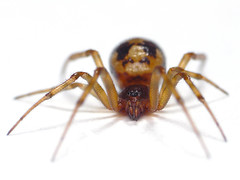 click for large
click for largeThe spider genus Steatoda, in the family Theridiidae, includes over 120 recognized species, distributed around the world including many cosmopolitan species which are found among human populations worldwide.
Many spiders of the genus Steatoda are often mistaken for widow spiders (Latrodectus), and are known as false black widows; however Steatoda are significantly less harmful to humans. Steatoda are shaped similarly to widow spiders, with round, bulbous abdomens. However, not all Steatoda species resemble widows – many have distinct coloring, and are significantly smaller than Latrodectus specimens. Some species of Steatoda actually will prey on widows, as well as other spiders which are considered hazardous to humans.
Some members of this genus do have bites which are medically significant in humans (such as S. grossa and S. nobilis), however bites by Steatoda species generally do not have any long-lasting effects. The symptoms associated with the bite of several Steatoda species are known in the medical profession as steatodism; and have been described as a less-severe form of latrodectism (the symptoms associated with a widow spider bite).
In common with other members of the Theridiidae family, the Steatoda spiders construct a cobweb, i.e., an irregular tangle of sticky silken fibers. As with other web-weavers, these spiders have very poor eyesight and depend mostly on vibrations reaching them through their webs to orient themselves to prey or warn them of larger animals that could injure or kill them. They are not aggressive, and most injuries to humans are due to defensive bites delivered when a spider gets unintentionally squeezed or pinched somehow. It is possible that some bites may result when a spider mistakes a finger thrust into its web for its normal prey, but ordinarily intrusion by any large creature will cause these spiders to flee.
Raynox DCR-150 and Raynox DCR-250
and Raynox DCR-250 , stacked and mounted on my Panasonic Lumix FZ8.
, stacked and mounted on my Panasonic Lumix FZ8.
Many spiders of the genus Steatoda are often mistaken for widow spiders (Latrodectus), and are known as false black widows; however Steatoda are significantly less harmful to humans. Steatoda are shaped similarly to widow spiders, with round, bulbous abdomens. However, not all Steatoda species resemble widows – many have distinct coloring, and are significantly smaller than Latrodectus specimens. Some species of Steatoda actually will prey on widows, as well as other spiders which are considered hazardous to humans.
Some members of this genus do have bites which are medically significant in humans (such as S. grossa and S. nobilis), however bites by Steatoda species generally do not have any long-lasting effects. The symptoms associated with the bite of several Steatoda species are known in the medical profession as steatodism; and have been described as a less-severe form of latrodectism (the symptoms associated with a widow spider bite).
In common with other members of the Theridiidae family, the Steatoda spiders construct a cobweb, i.e., an irregular tangle of sticky silken fibers. As with other web-weavers, these spiders have very poor eyesight and depend mostly on vibrations reaching them through their webs to orient themselves to prey or warn them of larger animals that could injure or kill them. They are not aggressive, and most injuries to humans are due to defensive bites delivered when a spider gets unintentionally squeezed or pinched somehow. It is possible that some bites may result when a spider mistakes a finger thrust into its web for its normal prey, but ordinarily intrusion by any large creature will cause these spiders to flee.
Raynox DCR-150
